Grandmasters will probably describe today’s eleventh game of the World Championship Match as “a boring draw.” However, I disagree! I think that this was a perfect game for introductory to intermediate players to study. The game was replete with little tactics and decisions that can help you gain an advantage in your games.
Of course, I understand the grandmasters’ point of view. In a match between the two strongest players in the world, they want to see them solving problems that are suitable for a 2800 player. Today’s game was like watching a putting competition between two great golfers, in which all of the putts are two feet or less. “Yup, he made that putt.” “Yup, he made that putt. Match still tied.” Etc., etc. Or it was like watching two great artists paint a picture by numbers. It was not worthy of their genius.
But for the rest of us … oh yes, it was worthy. Challenge yourself on this 10-question quiz and see if you, like Carlsen and Caruana, can make all of the “two-foot putts” effortlessly. (Questions nine and ten are the hardest, by the way. They might be equivalent to three-foot putts.) If you can answer all ten, congratulations! You, too, can play a boring draw. If not, sorry: You can play a boring loss.
FEN: rnbqkb1r/pppp1ppp/5n2/4N3/4P3/8/PPPP1PPP/RNBQKB1R b KQkq – 0 3
1. In this position, after 1. e4 e5 2. Nf3 Nc6 3. Nxe5, Caruana played 3. … d6. Why didn’t he play 3. … Nxe4?
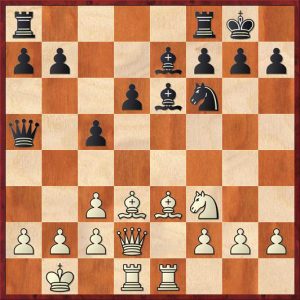
2. After 3. … d6 4. Nf3 Nxe4 5. Nc3 Nxc3 6. dc Be7 7. Be3 O-O 8. Qd2 Nd7 9. O-O-O Nf6 10. Bd3 c5 11. Rhe1 Be6 12. Kb1 Qa5, Black is threatening … Qxa2+ followed by … Qa1 mate. White has three reasonable ways to defend. What are they, and which one is best?
FEN: r4rk1/pp2bppp/3pbn2/2p5/2P5/3B1N2/PPPB1PPP/1K1RR3 b – – 0 14
3. The game continued 13. c4 Qxd2 14. Bxd2. Now White has a threat that Black must take seriously. What is it?
FEN: r4rk1/pp2bpp1/3pbn1p/2p5/2P4N/3B4/PPPB1PPP/1K1RR3 b – – 0 15
4. After Caruana’s 14. … h6, Carlsen played 15. Nh4. Where is the knight going? What is the biggest threat?
FEN: r5k1/pp2rpp1/3pb2p/2p5/2P3n1/3B4/PPPBRPPP/1K1R4 b – – 0 18
5. The game continued 15. … Rfe8 16. Ng6 Ng4 17. Nxe7+ Rxe7 18. Re2. Why can’t Black play 18. … Nxh2?
FEN: r5k1/pp2rpp1/3pb2p/2p1n3/2P2B2/3B4/PPP1RPPP/1K1R4 b – – 0 19
6. Of course, Caruana did not fall into the trap, and played instead 18. … Ne5, threatening the pawn on c4. Yet Carlsen did not defend the pawn. Instead he played 19. Bf4. Why can’t Caruana now win a pawn with 19. … Nxc4?
FEN:r5k1/pp2rpp1/3pb2p/2p5/2P2B2/3R4/PPP1RPPP/1K6 b – – 0 20
7. Of course, Caruana didn’t fall into that mistake! Instead he calmly traded material with 19. … Nxd3 20. Rxd3. But now he faces an interesting problem. He would like to take White’s weak pawn on c4, but he can’t. Why not? Meanwhile, Black has his own weak pawn on d6, which is attacked twice and not defended at all. It looks as if Black must lose a pawn. And yet he doesn’t! Step one: Free the bishop on e6. How can Black do this?
FEN: 3r2k1/pp3pp1/3Bb2p/2p5/2P5/8/PPP1RPPP/1K6 w – – 0 23
8. Caruana played 20. … Rd7!, unpinning the bishop and defending the pawn on d6. Now Carlsen had to avoid 21. Bxd6?, which would lose material after 21. … Bxc4. Instead he played 21. Rxd6 Rxd6 22. Bxd6, but here too the win of material is only temporary. For the record, Black could win back the pawn with 22. … Bxc4, but Caruana instead played 22. … Rd8, arriving at the above position. Why can’t White grab a second pawn with 23. Bxc5?
FEN: 6k1/p4pp1/1p5p/2p5/2b2B2/8/PPPK1PPP/8 b – – 0 26
9. Carlsen was forced to defend his bishop with 23. Rd2, after which Caruana played 23. … Bxc4. Then Carlsen played 24. Kc1 (breaking the pin on the bishop) and Caruana played 24. … b6 (finally defending the weak pawn on c5). Carlsen then played 25. Bf4 (we’ll see later why this is important) and Caruana traded rooks with 25. … Rxd2 26. Kxd2, arriving at the above position. Now it seems as if Caruana might be able to win a pawn with 26. … Bxa2, but that would actually be a catastrophic blunder. Why is the a-pawn taboo?
FEN: 8/5p2/p1k2Kp1/2P2P2/7P/P3B3/b7/8 b – – 0 54
10. In position 9, Black didn’t take on a2 but simply played 26. … a6. Many players would have agreed to a draw in this position or not much later, because opposite-color bishop endgames are notorious for being draws. However, Magnus Carlsen is willing to keep on playing where other players wouldn’t, and has proven his ability to convert tiny endgame advantages that other players wouldn’t dream of. A good example of this came 28 moves later (!), in the above position. White has just played 54. f5. It seems as if Black can simply trade pawns with 54. … gf — and yet this would cost him the game! Why is 54. … gf a terrible blunder? What should Black do instead?
Answers:
- After 3. … Nxe4? White plays 4. Qe2, and if Black continues playing copycat with 4. … Qe7 (his best move, actually) then White wins a piece with 5. Qxe4. However, it’s not over: Black actually wins back the piece with 5. … d6, when White cannot move his attacked knight. But White still stays a pawn ahead after 6. d4. It’s one of those positions that may not be a forced win for White, but his advantage is clear enough that virtually no one except beginners plays the “copycat” move 3. … Nxe4. One very important point is that if Black tries to rescue his knight with (4. Qe2) Nf6 or any other knight move, then 5. Nc6+ wins the queen with a discovered check.
- The three ways to defend are 13. a3, 13. b3, and 13. c4. It’s important to realize that every pawn move creates a weakness. The question is: Which of these weakens White’s king position the least? The problem with 13. a3 is that it creates a target or “hook” for Black to attack: he can play … b5, … Rb8, and then … b4 and White’s king becomes extremely unsafe. Likewise, 13. b3 would be bad because it creates a weakness on c3 — which Black is perfectly prepared to pounce on with 13. … Nd5 and 14. … Bf6. Of the three moves, 13. c4 creates the fewest weaknesses. The pawn shield for White’s king on a2-b2-c2 remains intact. Also, Black cannot attack the pawn with 13. … b5 because he has to deal with the threat of 14. Qxa5 first. After Caruana decides to trade queens (as he did), king safety is no longer an issue for Carlsen.
- The serious threat is 15. Ng5, attacking the bishop on e6. That piece is pinned because the bishop behind it on e7 is undefended. A good lesson for players of all levels: loose pieces drop off! And even if they don’t drop off, they create problems for other pieces. Also, notice what a big role is played by pins on the e-file in this opening. We’ll see that in questions 6 and 7, too.
- The knight could go to two squares: f5 or g6. Of the two, g6 is more serious because it forks the bishop and rook, and it is also more unexpected. This is the sort of threat that beginners often overlook. Note that the knight cannot be taken because White would play Rxe6, when both the undefended bishop on e7 and the undefended pawn on g6 would be attacked. Remember, loose pieces drop off! Caruana takes care of this problem in a very simple way–by defending the loose bishop on e7. Carlsen can still play 16. Ng6 (and does), but it no longer has as much venom.
- Think twice before capturing a pawn on h2 (or a2)! After 18. … Nxh2?? 19. f3 the knight cannot get out. White will then play 20. Rh1 and win a piece. It’s true that Black can get a second pawn for the knight, but that is not enough compensation. We’ll see another example of this theme in question 9.
- This is kind of an interesting question, because one would not normally think of the knight and bishop on e5 and e6 as being pinned pieces. Each one individually is free to move. But they’re not both free to move, so 19. … Nxc5?? 20. Bxc5 Bxc5 would drop the rook after 21. Rxe7.
- The pin on the e-file is still operative. If 20. … Bxc4?? 21. Rxe7 Bxd3 22. cd Black ends up a piece down. However, by playing 20. … Rd7! Black “activates” his bishop and makes … Bxc4 a serious threat. The lesson here is that good players generally don’t allow pieces to stay pinned for too long. Also, although Caruana seems to be losing the pawn on d6, he has a tactical resource to win back the pawn (see question 8). For this combination to work it was important to defend d6 with the rook, even though it seems insufficient at first glance.
- The move 23. Bxc5?? would run into the most severe punishment imaginable: 23. … Rd1 mate! If you stretch the definition, you can think of this too as a pin: the bishop on d6 is pinned by the threat of a back-rank mate.
- This one is a little bit trickier than the others, because the “obvious” answer is not quite as obvious as you think. If Black plays 26. … Bxa2 then White can, of course, trap the bishop with 27. b3. However, with 27. … c4! it seems as if Black might get the bishop out unscathed. For example, if 28. Kc3 cb 29. cb Bb1 and the bishop escapes. However, White has the wonderfully cold-blooded resource 28. Kc3 cb 29. Kb2!!, which prevents the bishop from reaching b1. And if Black replies 29. … bc, White can simply take on a2: 30. Kxa2. Notice that for this whole scheme to work, White’s bishop must be on f4 to protect the queening square. Otherwise Black would play 30. … c1Q and win. I think that it’s quite likely that Magnus was aware of this when he played 25. Bf4. So even in this seemingly calm, drawish, boring position, he was still looking six moves ahead! By the way, it’s not completely unheard of for a world championship-level player to miscalculate in this sort of position. In game 1 of the famous Fischer-Spassky match in 1972, Bobby Fischer took a similar poisoned pawn (this one on h2) with his bishop. No one quite knows why, but it seems as if he convinced himself that he had a freeing maneuver (like the move 27. … c4 above) that actually didn’t quite work. Ever since then, pawns on a2, h2, a7 and h7 that are attacked by bishops have been known as “Fischer pawns.”
- Remarkably, it is still possible for Caruana to lose this game. If he had played 54. … gf??, Carlsen would play 55. Bf4!! blockading the pawn. And amazingly, Black’s bishop has no way to stop the passed h-pawn from going h5-h6-h7-h8Q. This sort of trap is common when the passed pawn pawn is close to queening; however, it’s rare to see it when the pawn is four moves away from queening, as it is here! Kudos to Carlsen for continuing to make Caruana play carefully, even twenty moves after everybody was writing the game off as a dead draw. But kudos also to Caruana for seeing through Carlsen’s scheme. He simply played 54. … Bb1! Now if 55. fg fg, the g-pawn successfully prevents White’s h-pawn from queening. Or if 55. Kxf7 Bxf5, the same is true. Carlsen laid one more trap for Caruana, playing 55. Bf2 and hoping for 55. … Bxf5, when again 56. h5! gets the h-pawn past its vulnerable square. But Caruana simply played 55. … Bc2. We have an amusing mutual zugzwang, where Carlsen doesn’t want to take either on f7 or g6, and Caruana doesn’t want to take on f5 (at least as long as Carlsen’s king is on f6). Both sides are left with nothing better to do than make meaningless bishop moves forever and ever. Therefore Carlsen offered a draw, and Caruana accepted.
In retrospect, an amazing number of these tactical moments revolved around poisoned pawns — pawns that seem to be ripe for the taking but actually lead to severe illness or death. In fact, positions 5, 6, 7, 8, 9, and 10 are all poisoned-pawn positions. You might wonder, “Did Carlsen expect Caruana to take the poisoned pawn?” In other words, was he just playing traps and hoping that Caruana would blunder into them?
In most cases, I think that the answer was no. What a grandmaster does is use poisoned-pawn ideas as a tactical device to improve his position strategically. Magnus and Fabiano did that at least five times in this game, maybe even more. I would say that only the last one, the pawn on f5 in position 10, had no justification other than the hope that Black would take the poisoned pawn. At this very late stage in the game, Magnus had no other way to improve his position, so he was just playing “hope chess,” hoping that he could catch Fabiano napping.
Why is this important? Because I think that the typical amateur player will use a poisoned pawn for strategic purposes at most once a game, and probably much less often than that. When you see players doing it over and over and over, as Magnus and Fabiano did in this game, you know you are watching masters.
After eleven games, we have still not seen a win for either player. It’s been a strange match. A few of the draws, like today’s, have been of the “boring” type (though still instructive for us lesser players!). But many of them have been very hard-fought. In game ten, for example, the commentators were saying that the position could not end in a draw — one or the other player would have to win. Yet both players managed to thread the needle defensively and come out with a balanced position. What we are really seeing is incredible skill in defense.
You might think that after 11 draws, it’s a sure thing that game 12 will be a draw and that we will go to a playoff. But I would put the chances of a draw at somewhere between 50 and 60 percent. One reason is that Caruana really needs to push for a win in this game. Everyone says that he is distinctly weaker than Carlsen in rapid chess. Also, this game will be a good opportunity for him to push for a win, because he will have White. And in the last two games with White, games 8 and 10, both players voluntarily went into the Sveshnikov Variation of the Sicilian Defense, one of the sharpest and most uncompromising openings in chess. Although both games were drawn, this opening by its nature is not conducive to draws. If we get another Sveshnikov, I would put the odds of a draw at slightly less than 50 percent. If one player or the other goes for a tamer opening, then I think the odds of a draw will rise to maybe 70 percent.
We’ll see! And for anyone in the Santa Cruz area, please come to our fourth and last World Chess Championship Watch Party, at the Aptos Library on Monday morning from 10 am to noon (or until the game ends).
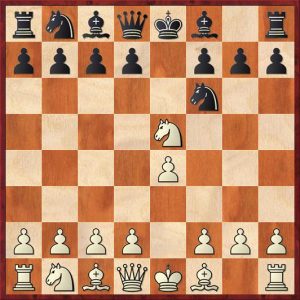
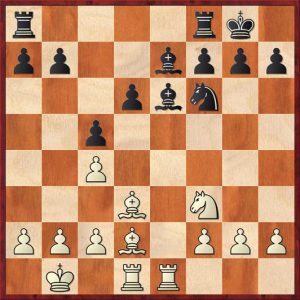
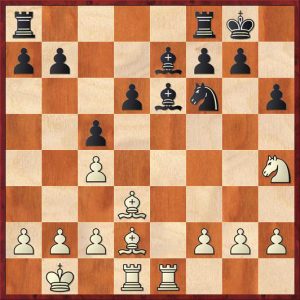
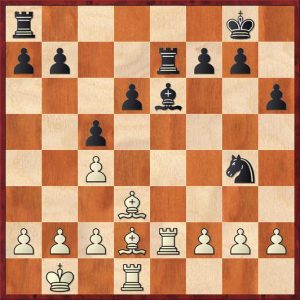
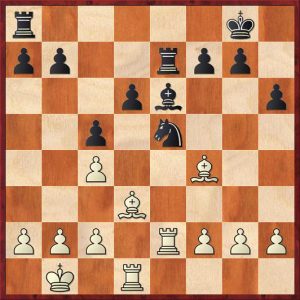
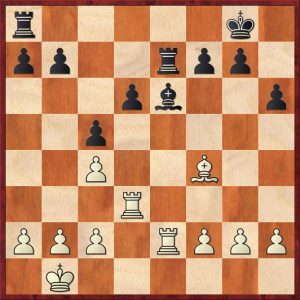
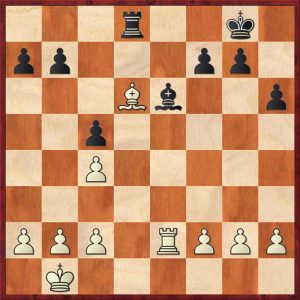
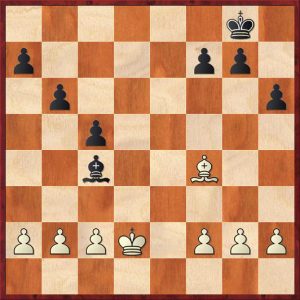
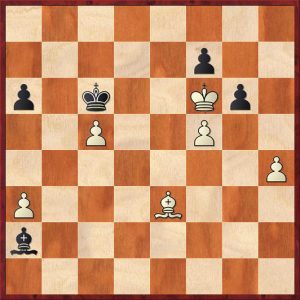



{ 1 comment… read it below or add one }
In the press conference Magnus mentioned the endgame Ljubojevic-Karpov. An exceptional game to learn how to try an win those kind of positions. Great article Mr Mckenzie!